Using the THSS
Step 1. Access the THSS
To access the THSS, TOMS logon credentials (i.e., username and password) are required.
- Open a web browser and navigate to the CAASPP website.
-
Select the Interim Assessments] button (figure 1) to navigate to the CAASPP Interim Assessment Administration Resources web page.
![[Interim Assessments] button
on the CAASPP website](/s/interim-assessments/thss/using-thss/2023-clip_image003.jpg)
Figure 1. [Interim Assessments] button on the CAASPP website
-
Select the [Teacher Hand Scoring System] button (figure 2).
![[Teacher Hand Scoring System] button](/s/interim-assessments/thss/using-thss/2023-clip_image005.jpg)
Figure 2. [Teacher Hand Scoring System] button
- Enter the required email address and password in the Email Address and Password fields on the Logon screen (figure 3), and then select the [Secure Logon] button.
-
If the password has been forgotten or otherwise needs to be reset, refer to Access, Logons, and Passwords in the CAASPP and ELPAC TOMS User Guide for instructions on resetting.
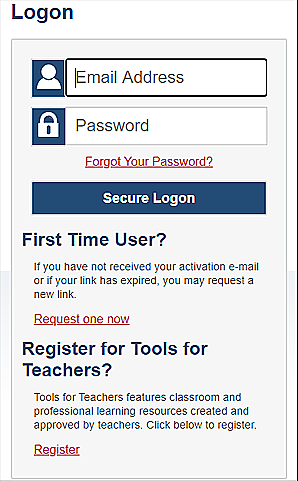
Figure 3. Logon screen
Step 2. Select School
Overview of the School Selection Screen
After logging on, the Select school screen will appear (figure 4). Scorers will select the school they wish to use by selecting the arrow from the drop-down list.
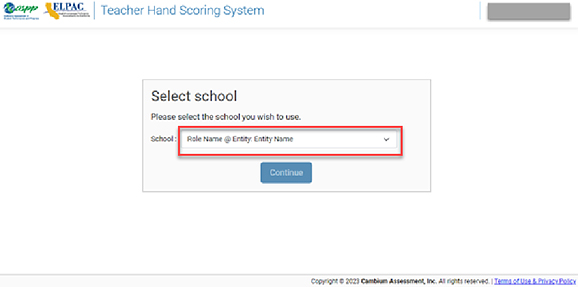
Figure 4. Select school screen—Scorer
- School drop-down list: This list includes the schools assigned to the scorer.
-
[Continue] button: This button remains suppressed until the scorer selects the school (figure 5).

Figure 5. [Continue] button
Step 3. Select Assessment to Score
After selecting the [Continue] button the scorer will be directed to the Dashboard—Assessments to score screen (figure 6). The Dashboard view shows the test programs that have been assigned to the scorer. Assessments to score are listed in this table.

Figure 6. Dashboard—Assessments to score screen
- Select the [Change school] button to return to the Select school screen.
- Test Name: The selected test to score in this column is accessed by selecting the link.
- Manner of Administration: This column is for interim assessments only. It indicates whether an interim was administered as Nonstandardized or Standardized/benchmark.
- Student Count: This column indicates the number of students who took the test.
- Items to Score: This column indicates the number of items to be scored.
- Items to Submit: This column indicates the number of scored items to be submitted.
- Date Last Taken: This column indicates the last date the students took the test.
- Navigation arrows: These arrows are used to view test names on other pages if the item list shows more than 25 students.
Step 4. Select Item Responses to Score
Overview of the Items to Score Screen
After selecting the test, the Test Scoring screen will appear (figure 7) The table on this screen (figure 7) is populated with the test items which are assigned to the scorer to be scored.

Figure 7. Dashboard—Test Scoring screen
- Select the [Dashboard ] link to return to the Assessments to score screen.
- Submit: Boxes in this column remain suppressed until all of a student’s items responses have been scored.
- Assign: Boxes in this column are available to assign scorers to item responses that are to be scored.
- Assignee: This column shows the name of the scorer to which the response is assigned. Use the toggle arrows to sort the names of the assignee in the column.
- Student Name: This column indicates the student’s name. Use the toggle arrows to move the student names forward or backward in the column.
- Student SSID: This column lists the SSID by student.
- Date Taken: This column lists the date and time the student took the test.
- Items to Score: This column is separated into two subcolumns based on the Item Sequence Number and Max Points. The [Score] link will change to the points earned number once an item response has been scored.
- [Score] link: This column provides the scoring status of the item. Select this link to score the student’s response.
- [Submit Score(s)] button: The button remains suppressed until the student’s test is scored. After a student’s test is scored and once the Submit checkbox (call out 2 in figure 7) for one of more students have been selected, the user can select this button to submit scores for the student(s)
- [Assign] button: This button, which is used to reassign student responses for scoring, remains suppressed until an Assign checkbox (callout 4 in figure 7) is selected.
- Navigation arrows: These arrows are used to view student responses on other pages if the list of scores shows more than the designated number of rows of students per page.
Sort the Test Scoring Table
The Test Scoring table can be sorted by assignee, student name, student SSID, and date taken.
Step 5. Score Item Responses
This section explains how to enter scores for responses.
-
In the Items to Score column of the Test Scoring screen (figure 7), select the [Score] link for the response. The Score Response screen appears, displaying the item rubric, anchor samples, and student response which is located under the [Item & Score] tab (figure 8).

Figure 8. Score Response screen
- In the “Response” section of the Score Response screen (figure 8), the tabs to change between [Item & Score] and [Rubrics & Resources] are at the top with the Points Earned (pencil icon) followed by the “Scoring Note” section, item prompt, stimulus, and the student’s response. Navigation buttons are at the top instead of the bottom of the screen.
- Selecting the down arrow on the spinner will go to the next student's item through the full set of students. When the bottom of the list is reached the button will gray out. Selecting the up arrow will return the scorer to the top.
- A collaboration feature in the THSS lets a scorer add note. Previous notes cannot be edited, but new notes can be entered into the Scoring Note field to preserve the history, including reassignment notes. Select the plus sign next to “Add Note” to add a note.
-
The scorer or score manager will scroll across in the Score Response screen to view the item card with the sequence number. Table 1 defines the terms used in figure 8. To view the item’s passage and an example of responses at all score points, select the [Exemplars] link (figure 11) which is located under the [Rubrics & Resources] tab.
The three parts of the response section (figure 8) are described in table 1, which follows.
Table 1. Score Response Screen Section Terms
Term Definition Item Prompt A test question or stimulus presented to a student to elicit a response Stimulus Material or materials used in the test context that form the basis for assessing the knowledge and skills of students Student Response Area The designated area for the student’s response to the item prompt -
To enter a score for the response, select the [Edit] pencil icon in the Points Earned field to manually assign a numerical score in the Score field or use the Score drop-down list to increase or decrease the score in increments of one (figure 9). The score cannot exceed the value in the Points column.
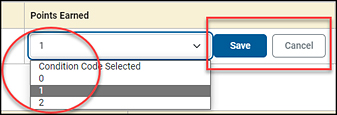
Figure 9. Points Earned drop-down list
-
Select the [Save] button to apply the score or [Cancel] (figure 9). The applied score(s) appears on the Score Item screen (figure 10). The Score Item view moves the student’s item to tentatively scored. Scores can be changed and resaved if there is a different opinion of the score. Scores are not applied until the student’s test has been submitted.
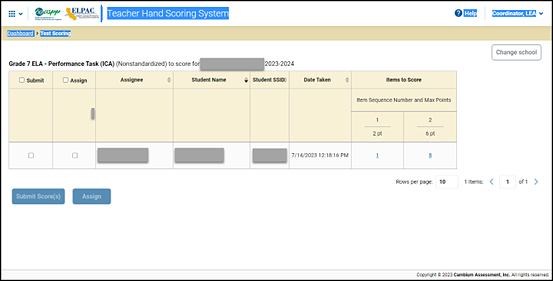
Figure 10. Test Scoring screen with applied item score(s)
- In the [Rubric & Resources] tab (figure 11), review the rubric description and do one of the following:
-
View anchor samples for each score point as a guide for scoring the student response. Select the [Exemplars] link (figure 11) located under the Resource field.

Figure 11. THSS Exemplar Samples “Resources” section
-
-
After finishing entering scores for the response, select [Submit Score(s)] at the bottom of the screen (figure 12). Note that the [Submit Score(s)] button remains suppressed until all the student tests are tentatively scored.

Figure 12. Navigation for the THSS
- To navigate to the Score Item screen for a different item, First close out the item being scored then select a [Score] link in an Items to Score column (figure 10); the order of responses is determined by the sorting options chosen on the Response List table.
- To return to the Response List screen, select [Score].
Reassign Responses
The THSS automatically assigns student responses for hand scoring to the test administrator or test examiner who administered the session in which the student test was completed. If a student started a test in one session and completed it in another, the response will be assigned to the test administrator or test examiner who administered the session in which the student completed the test.
Score managers at the school level (CAASPP test site coordinators and site ELPAC coordinators) can reassign responses to scorers in a school. Those score managers associated with an LEA (LEA CAASPP coordinators or LEA ELPAC coordinators) can reassign responses to scorers within the LEA.
What follows is the process for score managers to reassign responses.
- Select the assessment being scored.
-
On the Response List table (figure 12), mark the checkbox in the Assign column on the left for any student responses intended to be reassigned.

Figure 12. Response List table
-
Select the [Assign] button at the bottom of the Response List screen. The Assign Opportunity dialog box appears (figure 13).
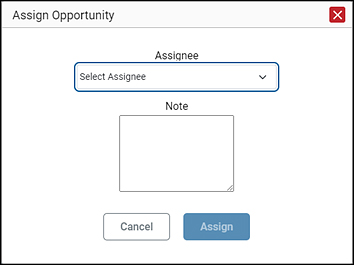
Figure 13. Assign Opportunity dialog box
- Select a scorer from the Assignee drop-down list shown in figure 13. Only users associated with the user’s school or LEA will appear.
- Enter text in the Note field in the Assign Opportunity dialog box (figure 13). This note will appear in the “Scoring Note” section on the [Item & Score] tab.
-
Select the [Assign] button. The selected responses are reassigned to the selected scorer. The newly assigned scorer’s name will show in the Assignee column of the table (figure 14); this display is available to score managers only. For scorers, once responses are reassigned, those responses are removed from the original scorers’ response list.
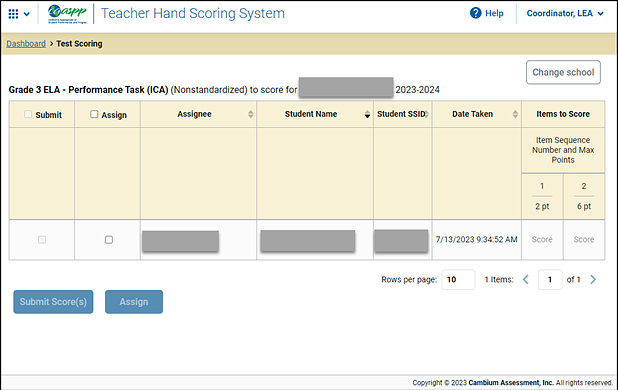
Figure 14. Reassigned Scorer’s table
Step 6. Submit Student Responses
After scoring responses, the scorer must mark the responses as complete to finish the process.
-
On the Test Scoring table, mark the checkbox under the Submit column for any responses that have final scores (figure 15). To select all responses, mark the checkbox next to the Submit header or each item response checkbox.
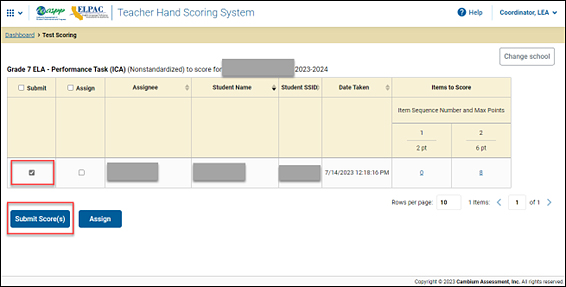
Figure 15. Response List table
- Select the [Submit Score(s)] button (figure 15).
-
In the Score Submit Alert message box (figure 16) that pops up, select the [Continue] button to submit the score or select [Cancel] to exit.
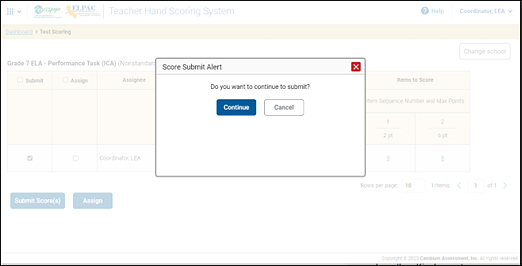
Figure 16. Score Submit Alert message box
-
Once a response has been marked as complete, it is removed from the scorer’s queue (figure 17). The score will disappear from the system.
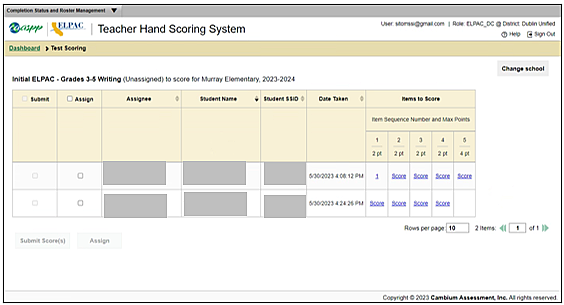
Figure 17. Response List table with Assignee column
Interim assessment score results are, generally, available within 20 minutes once all hand scoring has been completed. The results can be viewed in CERS. Because of regular quality assurance processes and the high volume of testing during peak summative testing times, some results might require more than 20 minutes to populate in CERS.
Teachers will need permission, by way of a TOMS role, to view test results for their student groups. Student groups are created by the LEA or site coordinator. Teachers who are unable to view their student groups should contact their school or LEA coordinator.
School administrators may view results for all students in the school, and LEA administrators may view results for all students in the LEA.

